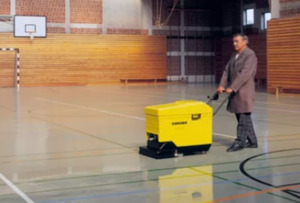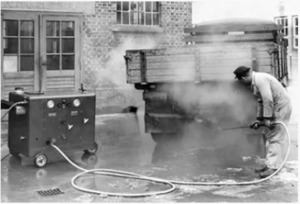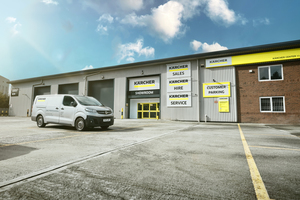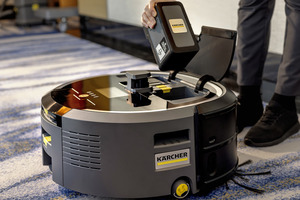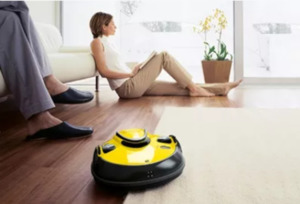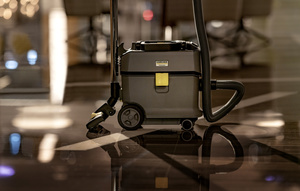

|
Chris Shaw
Editor |
| Home> | FACILITIES MANAGEMENT | >Infection Control & Prevention | >From steam to smart technology - a 90 year journey |
From steam to smart technology - a 90 year journey
13 August 2025
For 90 years, Kärcher has been innovating cleaning technology, solving real-world problems, and setting new standards in performance and reliability. To celebrate this milestone, Vivienne Speckamier explores the Kärcher product breakthroughs that have shaped the brand into a leading all cleaning solutions provider.

The origin story
Founded in post-war Germany by engineer and inventor Alfred Kärcher, the Kärcher business began by manufacturing equipment such as stoves, small cookers, and agricultural trailers, aiming to improve the day-to-day lives of workers and everyday people. The goal of the business was clear – engineering-led solutions that solve real world problems whilst delivering high performance and reliable results, something that is still driving Kärcher’s business.
However, it was not until 1950 that Kärcher would make its first truly revolutionary innovation, the introduction of the DS 350, transforming the cleaning industry.
The development of Europe’s first hot water pressure cleaner
The DS 350, Europe’s first hot water high-pressure cleaner, utilised steam jet technology to make the breakdown of industrial dirt, fats, and oils efficient and easy. The unique water heating system was so ground-breaking that it still underpins Kärcher’s hot-water pressure washers today.
The DS 350 established Kärcher as an industry leader within the cleaning sector and laid the foundation for future development within the company.
70s shift, 80s innovation
In 1974, under the leadership of Alfred’s wife Irene, Kärcher made a decisive shift away from steam cleaners and general manufacturing products to specialise in high-pressure washers for professional users. This strategic change allowed Kärcher to invest in rapid innovation, establishing the brand as the leading cleaning provider for high-pressure technology. This was evidenced by a Guinness World Record as the best-selling pressure washer brand and Kärcher’s role in the cleaning of Christ the Redeemer in 1980.
During this time, Irene also introduced Kärcher’s now-iconic yellow for outdoor domestic machines – a distinctive visual identity that has made the products instantly recognisable.
By 1986, Kärcher had set the standard in the professional sphere with the launch of the BR 450 floor cleaning machine, built with a revolutionary roller brush technology. This innovation enhanced work efficiency and continues to remain a gold standard with 50% of scrubber drier machines using roller brush technology even today.
Welcoming in the Millenium
Kärcher’s approach to innovation continued into the 2000s, expanding its product offering beyond professional and industrial machines, and into the consumer market.
In fact, in 2003, Kärcher announced the RC 3000, the first fully autonomous household cleaning robot, bringing professional-grade innovation to everyday people.
Then in 2008, the development of the WV 50, the first battery-powered window vacuum, further propelled Kärcher’s product offering and opened a new category for cleaning equipment. The window vac has since become one of Kärcher’s most successful products, with over 25 million units sold globally.
A focus on sustainability
In the early 2010s, growing awareness around damage to the environment made it clear that more sustainable cleaning practices would need to be adopted by both businesses and consumers.
In response, Kärcher launched the T 12/1 eco in 2011, a vacuum cleaner developed to deliver professional-grade cleaning with significantly lower energy consumption. This development marked the beginning of Kärcher’s eco!efficiency mode, a feature which has since been integrated with multiple products to reduce resource use and noise pollution. For example, the innovative new successor range, made with high recycled content and energy-efficiency, features the T 10/1 HEPA Bp battery-powered dry vacuum cleaner, which is made from 45% recycled material and meets the highest safety standards in hygiene sensitive areas.
These advancements have supported businesses in meeting sustainability targets while maintaining the same quality of cleaning performance, proving that environmental responsibility does not come as a cost to operational excellence.
Furthermore, Kärcher’s commitment to sustainability goes beyond products, shaping everything from its workshops to its offices. With energy consumption at its Banbury HQ already cut by 52% since 2020 – thanks to the installation of 966 solar panels – and a clear goal of reaching net zero, the company is rapidly achieving its ESG targets.
During this period, Kärcher’s product colour evolution continued, introducing anthracite to signify its professional range – helping users to distinguish between the product lines.
Entering a new decade of innovation
In the 2020s, Kärcher continues to innovate through investment in robotics and AI powered cleaning solutions, most notably with the launch of the KIRA CV 50. Compact, lightweight, and fully autonomous, this next generation vacuum was designed to operate across a wide range of environments and surfaces with ease.
The KIRA CV 50 reflects a new generation of cleaning machines built for efficiency, consistency, and intelligent, data-led cleaning. This development exemplifies Kärcher’s momentum and dedication to innovation, while also highlighting a wider industry shift towards integrated, autonomous systems that maximise results while minimising labour demands and resource consumption.
The future of Kärcher
As Kärcher looks ahead to the next 90 years, the innovative cleaning provider will be focusing on sustainability and robotics – with an ever-growing range of autonomous and eco-focused products set to hit the market.
Kärcher’s philosophy
Kärcher continues to champion its ‘renew to sustain’ philosophy – an approach that challenges the throwaway culture of single-season machines by designing durable, repairable equipment that minimises waste and environmental impact. Modular systems allow for easy part replacement without compromising the entire machine, while Kärcher’s eco!efficiency mode cuts costs and mechanical strain without reducing performance. When machines do reach the end of their service life, Kärcher has robust systems in place to recycle components and recover valuable materials.
All-in-one cleaning, all in one place
As the demands of professional cleaning operations continue to grow, Kärcher is evolving beyond machinery to become a true all solutions provider with bricks and mortar facilities to match.
The development of Kärcher Centres (KOKOs) reflects this shift, offering cleaning professionals a streamlined, in-person experience that brings together equipment, servicing, training, and support under one roof.
This all-in-one approach is further strengthened by Kärcher’s ability to service machines from any brand, giving facilities managers the option to streamline maintenance, regardless of the machine’s brand. This helps reduce admin load, minimise downtime, and improve machine longevity – giving facilities managers more time to focus on operations.
Overall, Kärcher’s legacy of innovation, from the DS 350 to the latest in autonomous cleaning with the KIRA CV 50, is rooted in solving real-world problems and bettering the lives of its consumers, staying true to Alfred and Irene Kärcher’s vision. Looking ahead, the brand remains committed to increasing sustainability, tackling business’ pain points and leading the cleaning sector with intelligent, purpose-driven cleaning solutions.
Vivienne Speckamier is professional product manager at Kärcher Professional
For more information, visit www.kaercher.com
- Battery-powered landscape management
- Kärcher launches first of its kind dry ice blaster
- Kärcher focuses on battery technology
- One-stop-shop for cleaning and care advice
- Kärcher Professional strengthens UK team
- Just add water
- Kärcher UK launches industrial cleaning equipment hire service
- Karcher expands into Ireland
- SG 4/2 Classic steam cleaner
- Kärcher Professional UK announces exclusive offer
- Developed to protect the US military – now fighting UK germs
- The POD – Reduce your paper consumption by up to 20%
- Barcode traceability
- Say goodbye to germs in the workplace
- Weapon in war on superbugs
- Protects knee from infection
- Accessible & educational
- Rent disinfection unit
- Stop cross contamination
- Antimicrobial kneepads
